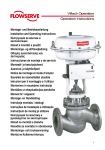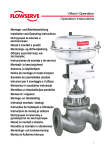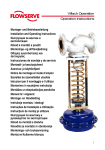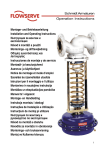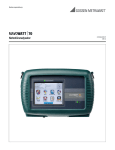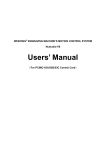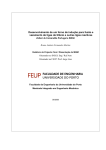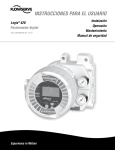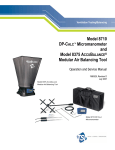Download Installation and Operating Instructions Инструкция за
Transcript
Montage- und Betriebsanleitung Installation and Operating Instructions Инструкция за монтаж и експлоатация Návod k montáži a použití Monterings- og driftsvejledning Οδηγίες εγκατάστασης και λειτουργίας Instrucciones de montaje y de servicio Montaaži- ja kasutusjuhend Asennus- ja käyttöohjeet Notice de montage et mode d’emploi Szerelési és üzemeltetési utasítás Istruzioni per il montaggio e l’utilizzo Montavimo ir naudojimo instrukcija Montāžas un ekspluatācijas pamācība Manwal ta’ l-Apparat Montage- en Handleiding Instrukcja montażu i obsługi Instruções de Instalação e Utilização Instrucţiuni de montaj şi utilizare Инструкция по монтажу и руководство по эксплуатации Návod na montáž a obsluhu Navodila za montažo in obratovanje Monterings- och bruksanvisning Montaj ve Kullanma kılavuzu Montage- und Betriebsanleitung Installation and Operating Instructions Инструкция за монтаж и експлоатация Návod k montáži a obsluze Monterings- og driftsvejledning Page 15 - 24 страница 25 - 34 Strana 35 - 44 Side 45 - 54 Οδηγίες εγκατάστασης και λειτουργίας Σελίδα 55 - 64 Instrucciones de montaje y de servicio Página 65 - 74 Montaaži- ja kasutusjuhend Asennus- ja käyttöohjeet Lehekülg 75 - 84 Sivu 85 - 94 Notice de montage et mode d’emploi Pages 95 à 104 Szerelési és üzemeltetési utasítás 105 - 114. oldal Istruzioni per il montaggio e l’utilizzo Montavimo ir naudojimo instrukcija Montāžas un ekspluatācijas pamācība Manwal ta’ l-Apparat Pagina 115 - 124 p. 125 – 134 135. – 144. lappuse Paġni 145 - 154 Montage- en Handleiding Pagina 155 - 164 Instrukcja montażu i obsługi Strona 165 - 174 Instruções de Instalação e Utilização Instrucţiuni de montaj şi utilizare DE EN BG CS DA EL ES ET FI FR HU IT LT LV MT NL PL PT RO RU SK SL SV TR Seite 5 - 14 Páginas 175 - 184 Paginile 185-194 Инструкция по монтажу и руководство по эксплуатации стр. 195 - 204 Návod na montáž a obsluhu Strana 205 - 214 Navodila za montažo in obratovanje Stran 215 - 224 Monterings- och bruksanvisning Sidan 225 - 234 Montaj ve Kullanma Kılavuzu Sayfa 235 - 244 Contents Preface Scope Product description 1. 1.1 1.1.1 1.1.2 1.2 1.3 2. 3. 4. 4.1 Installation “As delivered” status Transport Storage Preparation for installation into the piping Rating plate Installation of the control valve Recommended installation Commissioning Flange connection Welded connection Maintenance Repair Troubleshooting, service and repair centres Page EN 15 16 16 16 17 17 17 17 18 18 + 19 19 20 20 21 22 22 23 + 24 This control valve was manufactured to the strict standards of our ISO 9001 certified quality management system. It was tested for compliance with all applicable regulations and guidelines and fully conforms with all contractually agreed specifications. To ensure a faultless and reliable operation of this product, please read and observe these installation and operating instructions before using this product. Failure to comply with these installation and operating instructions will render the manufacturer’s guarantee and liability null and void. Unless otherwise agreed, the manufacturer’s General Terms and Conditions of Sale shall apply. 15 EN Scope These operating instructions shall apply to: • • • • • with fitted pneumatic or electrical linear actuator with fitted linear unit and electrical rotary actuator • with or without accessories Product description Control valves control gases, vapours or liquids and change the flow conditions of a process. The control valves consists of the body (valve bottom) and the actuator which, depending on the control signal, changes the position of the closure member (plug) relative to the seat. The bodies have been arranged in logical kits, allowing the user to assemble the highest possible number of variants from a minimum of components to match each individual application. Our range also includes a series of peripheral units such as positioners, boosters, filter-reducing stations or solenoid valves. Positioners and solenoid valves can be assembled directly or according to NAMUR recommendations. Refer to the relevant manufacturer’s instruction manual for information regarding peripheral equipment. Single-seated control valves (PN 10–160, Class 150–900) Lined single-seated control valves (PN 10/40) Three-way control valves (PN 10–160, Class 150–600) Double-seated control valves (PN 10–160) Special valves 1. Installation 16 The valve must be installed and commissioned by qualified staff. Qualified staff is defined as personnel who are familiar with the installation, commissioning and operation of this product and possess the relevant qualifications in their field of activity. 1.1 “As delivered” status Control valves are generally delivered as tested and assembled units with the actuators fitted. Parts of the body and actuator subject to corrosion are protected by a coat of paint. Unpainted components are greased and the openings of the housings are closed with plugs. High-grade steel housings are delivered without a protective coat of paint (pickled or blasted). 1.1.1 Transport Careful loading and transport arrangements are required to avoid the product suffering impact and jolting movements. Under no circumstances should lifting gear be attached to the valve spindle, travel indicator and any peripheral units, if applicable. We recommend the use of a length of rope that is looped around the valve head underneath the yoke (or the transportation eyelet(s)). The maximum permitted carrying capacity must be observed. Promptly touch up any damage to the corrosion protection. 1.1.2 Storage Upon arrival on site, store the control valve on a solid base in a closed room. Until its installation, the valve must be protected from the weather, dirt and other potentially harmful influences. Under no circumstances should the valve remain in storage for more than 6 months, as the impregnation in the stuffing box packing evaporates and leaks may develop. Do not remove the plugs protecting the flanges and the inside of the control valve until it has arrived at its place of installation. 1.2 Preparation for installation into the piping The pressure, leak and operation tests performed in the factory and the quality management system introduced by the manufacturer ensure that the execution of the control valve complies with the specifications set forth in the contract The series number and the vital valve actuator data are found on the rating plate. The travel indicator shows the position of the closure member relative to the seat. Before installing the valve, carefully clean the piping. 17 EN Rating plate EN As the information on rating plates reflects the special features of the type they describe, their appearance may differ. The rating plate contains the following data: Kennzeichnung / Tag No. Typ / Type DN / PN Sitz ø / Seat ø Kvs / Cv Kegel / Plug Kennlinie / Characteristic Mat. Gehäuse / Mat. Body Innenteile / Trim Packung / Packing Betriebsdruck / Working Pressure Fabrikations Nr. / Serial No. Antrieb Typ / Actuator Type Hub / Stroke Zuluft min. max. / Supply min. max. Federlaufbereich / Spring Range Sicherheitsstellung / Failure Position Umgegungstemp. / Ambient Temp. ∆p Antrieb / ∆p Actuator Einbaulage / Arrangement Betriebstemperatur / Working Temperature 1.3 Before installation, check the following items: • The operator is required to carefully check the suitability of the control valve for its intended use in the system in advance. Any use not in compliance with the regulations/specifications can lead to serious damage to the control valve or may lead to failure of the facility! • Does the nominal/operation data on the rating plate match the operational data of the facility? A mismatch may cause considerable damage to the valves. • At the point of installation, is there enough space to fit and remove the valve? A lack of space can cause considerable problems and in the some cases necessitate expensive rerouting of the piping! • Was the piping flushed and cleaned prior to the installation? Foreign particles can damage the control valve and accessories; this can be avoided by fitting a suitable dirt trap. • Was the protective coat removed from the control valve, and was the valve cleaned? The preservative (Mipa Abziehhaut blue) and the spray (Castrol Safecoat DW 32) can contaminate the operating medium and must be removed before installation. Unsuitable cleaning agents that attack the PTFE and graphite sealing sets can cause damage and leaks. Pay particular attention to the relevant chemical resistance lists. Remove covers. • Does the direction of flow arrow on the housing coincide with the direction of flow of the medium? If not, critical operating conditions can result that may damage the control valve, as they are not designed to cope with this situation. 18 • Are the piping flanges equiaxial and parallel and does the distance between pipe ends correspond to the valve length? If not, excessive tension, valve malfunctions and leaks at the flange connections may result. • Is the piping routed correctly and is the valve free from additional piping forces? If not, leaks may develop and, depending on the situation, the valve may fail. • Is the installation position of the valve with vertical valve spindle achieved? If not, increased wear in the stuffing box packing, leaks and, depending on the situation, rubbing may occur. Contact the manufacturer if the prevailing installation conditions mean that the valve will have to be fitted horizontally. • Is there a suitable surge section upstream and downstream of where the valve is installed? The absence of a surge section can create critical operating conditions and cause impermissible levels of noise and vibration! • Is appropriate equipotential bonding provided? Impermissible electrical compensating currents across the valve and the actuator can generate static and cause electrical discharging. In explosive atmospheres, the only valves that may be used are those that comply with the permitted group, equipment category and temperature class requirements laid down in Directive 94/9/EC (ATEX)! Recommended installation Successful use of the control valve is conditional on the availability of a suitable installation environment. We suggest that the recommended values be adhered to, as it is very important to take account of physical aspects when using the control valve. Deviations can result in significant control deviations, and in the worst case expensive rerouting of the piping will be necessary. However, some physical processes will permit a deviation from these values, although in such cases system knowledge is required, as is the express approval of the manufacturer. Recommended installation for control valves Control valve Dirt trap (0.1 mm) Medium Installation distance from valve 10 x DN (at least 1m) 19 EN 2. Commissioning The medium and the valve can pose the following hazards: • Critical operating conditions can cause impermissible levels of noise and vibration. EN Hearing loss, vascular and nerve problems, damage to joints and bones! • Incorrect maintenance can result in the emission of thermal, cryogenic and toxic operating media. Danger of burns, freezing, acid burns, poisoning! • The temperature of the operating medium is transferred to the surface of the valve. Danger of burns, freezing, explosion! As these hazards can all be controlled by the plant operator, the operator is obliged to comply with national and international environmental regulations, install suitable protective measures to ensure workplace requirements are satisfied, and to instruct his employees accordingly. Due to the risk of injury, it is prohibited to work between the yoke/columns while the valve is in operation. Once these hazards have been averted by adopting appropriate protective measures, the valve can be installed and connected in the piping. The following points should be noted: • Flange connection: Connection material (gaskets, bolts, nuts) are not part of the scope of supply. Locate gaskets in the centre of flanges, failure to do so can result in leaks and increased noise levels. If a completely installed piping is to be flushed or blown through for cleaning, replace the control valve with a matching piece. • Welded connection: Welded connections have to be made in compliance with applicable welding regulations. After welding, carefully clean the piping again. Open control valves properly and remove any accumulated foreign particles. Advise the manufacturer in writing that the fitting has been opened! 20 When the control valve is installed in the piping: • connect instrument air to the actuator or installed accessories (applies to pneumatic linear actuators). • connect according to the wiring diagram in the removable actuator cover or according to manufacturer’s actuator documentation (applies to electrical rotary/linear actuators). • Continuously increase load until operation parameters are reached. Sudden exposure of the control valve to the full working pressure and working temperature may cause stress cracks. • After the first loading (trial run) in depressurised and cool conditions, evenly tighten screw connections of sealing components crosswise (if required). Be careful to prevent damage to the high quality spindle surface finish! A damaged spindle surface finish may be detrimental to the smooth operation of the stuffing box. • Excessive levels of noise and vibration during operation indicate critical operating conditions and must be avoided at all costs. Impermissible continuous operation of control valves under critical conditions can damage the valves, as they are not designed to cope with this situation. • Avoid frequent system start-ups and shutdowns. Experience has shown that critical operating conditions, which can damage the control valve, are often encountered when starting up or shutting down the system. • Keep the operating medium free of foreign particles. Foreign particles can damage the control valve; this can be prevented by fitting a suitable dirt trap. • The instrument air must conform to at least the ISO 8573-1 class 2 or the requirements of the accessory manufacturer. Contaminated instrument air can damage the accessories and valve or cause them to fail. Bodily injury or damage to the control valve and its accessories as the result of nonadherence to warning instructions, as well as transport damage and improper use (e.g. as a climbing aid, etc.), will render the manufacturer’s guarantee null and void and release him from any responsibility. 21 EN 3. Maintenance EN Measure Interval Clean valve and actuator spindle with a soft cloth Tighten if stuffing box leaks Caution: Do not „over seal“ the stuffing box! depending on degree of contamination Standard stuffing boxes subjected to “normal“ operating conditions every 10,000 strokes Standard stuffing boxes subjected to “difficult“ operating conditions • packing exposed to aggressive medium • major temperature change during operation • occurrence of vibrations • unfavourable installation position Check spring tension and tighten if necessary every 5,000 strokes Spring loaded stuffing box systems and “normal“ operating conditions every 100,000 strokes at least once per year Spring loaded stuffing box systems and “difficult“ operating conditions every 10,000 strokes Pneumatic linear actuators maintenance free Electric linear/rotary actuators Check spindle/gear if required, lubricate Electric linear/rotary actuators Grease (grease nipple) 4. Repair largely maintenance free every 200,000 up-and-down strokes at least once per year If a fault or defect occurs which, according to the list of measures below, requires the customer services department or contract partner to be contacted, the manufacturer’s guarantee shall be rendered null and void - and the manufacturer released from any responsibility - unless the customer services department or contract partner is duly notified. If the customer performs the repairs himself, these operating instructions and the respective disassembly/assembly instructions must be followed to the letter and carried out in a competent manner. Original replacement parts must be used in every case. Control valves are pressure vessels! Improper opening of the actuator or fitting may result in bodily injury! 22 4.1 Trouble shooting Defect Spindle does not move No. Possible causes 1.1 • no aux. energy supply (pneumatic air or electrical power) to actuator and accessories (solenoid valve, filter-reducing station, positioner, limit switch and special accessories) • pneumatic actuators: check supply line for leaks check pressure (usually 6 bar) • electrical actuators: check power supply (connections, circuit breakers, voltage) 1.2 • the fitted accessories do not work • see maintenance and operating instructions of accessories manufacturer 1.3 • the pneumatic defective is • contact customer services department or contract partner 1.4 • the electrical actuator is defective • see maintenance and operating instructions of actuator manufacturer 1.5 • excessive tightening of the stuffing box packing • loosen stuffing box packing nuts until valve operates properly actuator Caution: Jolting spindle movement Spindle travel less than full stroke (0 to 100% stroke) or flow rate is too low EN Remedy make sure there are no leaks! 1.6 • valve trim worn, stuck • contact customer services department or contract partner 2.1 • the electrical actuator is defective • clean spindle with suitable cleaning agent 2.2 • damaged spindle • contact customer services department or contract partner 2.3 • actuator not powerful enough • compare actuator specs on the rating plate with operation specifications of the facility - if incompatible, contact customer services department or contract partner 3.1 • air supply pressure too low • provide air at the pressure stated on the rating plate 3.2 • pneumatic actuators: bad hand wheel position (hand wheel emergency operation) • move hand wheel to limit position 3.3 • electrical actuators: limit switch misadjusted • readjust limit switch to actuator manufacturer‘s specification 3.4 • badly adjusted positioner defective • readjust positioner to positioner manufacturer‘s specifications 3.5 • foreign particles in valve seat, damaged trim • contact customer services department or contract partner or 23 Trouble shooting - continued EN Defect No. Possible causes Remedy Excessive valve-seat leakage 4.1 • damaged sealing edges at valve seat or plug • contact customer services department or contract partner 4.2 • foreign particles in seat area • contact customer services department or contract partner 4.3 • plug does not close fully • refer to 3.1 to 3.5 5.1 • compression force on packing too low • slightly re-tighten stuffing box packing • worn packing • slightly re-tighten stuffing box packing Leaking stuffing box system 5.2 Caution: Caution: make sure the valve spindle can still move! make sure the valve spindle can still move! if the packing does not stop leaking, contact customer services department or contract partner 5.3 • dirty spindle • clean spindle with suitable cleaning agent 5.4 • damaged spindle • contact customer services department or contract partner 6.1 • pressing force on seal(s) too low • properly re-tighten top or lid nuts crosswise 6.2 • seals(s) defective • contact customer services department or contract partner Leaking housing 7.1 • medium- or flow-related damage • contact customer services department or contract partner No limit switch signal 8.1 • power supply to limit switch interrupted • check power supply (connections, circuit breakers, voltage) 8.2 • limit switch misadjusted • readjust limit switch; operating distance see limit switch data sheet 9.1 • defective positioner • see maintenance and operating instructions of positioner manufacturer Leaking top or lid seal Vibrating positioner If the problem is not solved by taking the above measures, contact the customer services department or contract partner. Service hotline Austria: Service hotline Germany: +43 (0)664 341 8 616 +49 (0)2157-8176-29 or +49 (0)163-8176-014 24 245 246 EG Konformitätserklärung / EC Declaration of Conformity gemäß DGRL 97/23/EG / acc. to PED 97/23/EC gemäß Richtlinie 90/396/EWG / acc. to Directive 90/396/EEC gemäß ATEX 94/9/EG / acc. to ATEX 94/9/EC gemäß Richtlinie 2006/42/EG / acc. to Directive 2006/42/EC Hersteller/Manufacturer Richtl./Dir. 2006/42/EG EN 161, DIN 3394 EN 264 DIN 32725 SIL IEC 61508 ISO 15848 VDI 2440 Autom. Absperrarmaturen für gasförmige Brennstoffe u. Sicherheitsabsperreinrichtungen für flüssige Brennstoffe Automatic shut-off valves for inflammable gases and Safety shutoff devices for inflammable liquids Type D726, D738, D740 Stellgeräte FlowTop Control valves FlowTop Type V726, V738, V740 Stellgeräte / Control valves Type V724, V760 Stellgeräte / Control valves Type V725, V723 Stellgeräte / Control valves Type MarkOne, Mark100, MarkSix Stellgeräte / Control valves Sonderregelventile / Special control valves 1) Einspritzkühlventile Injection nozzle valves Type V901 Selbsttätige Regler Self acting regulators Type 5801, 5610 Pneumatische Antriebe / Pneumatic actuators Type FlowAct, Valtek Piston Actuator ATEX 94/9/EG Produkte / Products Richtl./Dir. 90/396/EWG Richtlinien / Directives DGRL/PED 97/23/EG Mod. FLOWSERVE (Austria) GmbH Control Valves – Villach Operation Kasernengasse 6, A-9500 Villach B+D ● ● ● ● ● ● ● B+D H ● ● ● ● ● ● H ● ● ● ● H ● ● H ● ● ● H ● ● ● H ● H - ● ● ● 1) Für den Europäischen Markt / for European Market Benannte Stelle für die Kontrollen / Notified Body for the Inspections DGRL 97/23/EG / PED 97/23/EC TÜV CERT-Zertifizierungsstelle für Druckgeräte der TÜV Anlagentechnik GmbH Am Grauen Stein, D-51101 Köln Kennummer der Benannten Stelle / Number of Notified Body 0035 Richtlinie 90/396/EWG / Directive 90/396/EEC DVGW Zertifizierungsstelle Technisch-wissenschaftlicher Verein Josef-Wirmer-Straße 1-3, D-53123 Bonn Kennummer der Benannten Stelle / Number of Notified Body 0085 Management - System / Management - System OHSAS 18001:2007, ISO 14001:2004, ISO9001:2008 DNV Zertifizierung und Umweltgutachter GmbH Schnieringshof 14, D-45329 Essen Bevollmächtigter des Herstellers in der EG Authorized representatives of the manufacturer in the EC Villach, 09.11.2009 Dipl.-Ing. Arnold Muschet Technischer Leiter / Technical Director Ing. Herbert Schifferl QM Leiter / QM Manager 247 TM Indicates a trade mark of Schmidt Armaturen. Information given in this leaflet is made in god faith and based upon specific testing but does not, however, constitute a guarante. Modifications without notice in line with technical progress OI 133414 11/09 Control Valves eu ����������������� Flowserve (Austria) GmbH Control Valves - Villach Operation Kasernengasse 6 A-9500 Villach Telephone:+43 (0) 4242 41181-0 Facsimile: +43 (0) 4242 41181-50 or 51 e-mail: [email protected] www.flowserve.com 248 SAEUOIVALV-04 11.09


















